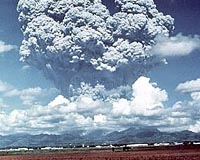| . |  |
. |
Reykjavik (AFP) May 23, 2010 Iceland's Eyjafjoell volcano is no longer in activity, a geophysicist said Sunday, raising hopes the eruption which has heavily disrupted European flights for more than a month could be over. "What I can confirm is that the activity of the crater has stopped. No magma is coming up" Magnus Gudmundsson of Iceland University told AFP. "The eruption, at least for the time being, has stopped. Now there is only steam coming out of the crater," he said, cautioning however that "it is too early to tell whether this is the end of the eruption or just a temporary stop in activity." Experts would be monitoring the volcano, which began eruption on April 14, very closely in the days and weeks to come. "I would say if there are no new earthquakes and no new outburst, then that would suggest that it is over," Gudmundsson said, adding that it could take a very long time before it would be possible to say for sure. "If you call me in one year's time, I could be pretty certain," he said, pointing out that the previous eruption at the volcano lasted 13 months, from 1821-23. "It stopped and started again several times with different intervals, so it's difficult to say, difficult to give a timeline," he said. The latest eruption at Eyjafjoell also began just a day after a more peaceful eruption ended on the Fimmvurduhals flank of the same volcano. Experts have cautioned that once the current eruption halted, a new blast in another crater or in the neighbouring and much larger and fiercer Katla volcano might follow. When or if that will happen is also, according to Gudmundsson, "impossible to say." In recent days, experts had said the activity at the Eyjafjoell volcano, which peaked for a third time just over a week ago, had slowed significantly. Gudmundsson however said it was difficult to tell exactly when the activity had stopped. "The flow of magma was very small yesterday, but it was still erupting at 5:00 to 6:00 pm (1700-1800 GMT). Ash was falling to the west of the volcano," he said, adding that "there has not been any eruption since at least this morning." During Eyjafjoell's highest activity peak in the week after it began erupting, it released ash enough to cause the biggest aerial shutdown in Europe since World War II, affecting more than 100,000 flights and eight million passengers.
Share This Article With Planet Earth
Related Links Bringing Order To A World Of Disasters When the Earth Quakes A world of storm and tempest
 Life Versus The Volcanoes
Life Versus The VolcanoesMoffett Field CA (SPX) May 20, 2010 The ocean's version of the La Brea Tarpits has been discovered off the Santa Barbara coast, so-called asphalt volcanoes that probably added a lot of methane to the atmosphere when they were active some 35,000 years ago and deposited massive flows of petroleum offshore. The underwater volcanoes are part of a larger structure of tar deposits in the area, and although the volcanoes themselves ... read more |
|
| The content herein, unless otherwise known to be public domain, are Copyright 1995-2010 - SpaceDaily. AFP and UPI Wire Stories are copyright Agence France-Presse and United Press International. ESA Portal Reports are copyright European Space Agency. All NASA sourced material is public domain. Additional copyrights may apply in whole or part to other bona fide parties. Advertising does not imply endorsement,agreement or approval of any opinions, statements or information provided by SpaceDaily on any Web page published or hosted by SpaceDaily. Privacy Statement |